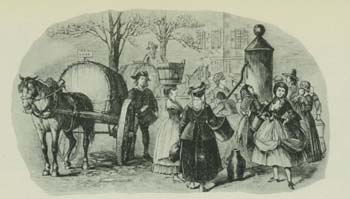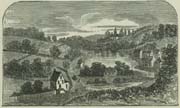The Tea Water Pump and the Collect Pond.
For the few city residents living north of Canal Street, two other sources of fresh water were available. The privately-owned “Tea Water Spring,” located near the present-day Chatham Green Houses, became a legendary source for New Yorkers even into the 19th century. Patrons could partake of “the superior excellence of its water” by purchasing casks of it from suppliers called “Tea Water Men,” who charged the low price of two cents per gallon for their bounty. Those who could not afford water from the Tea Water Spring or who were doubtful of its purity could opt to draw water from the nearby “Collect” pond. The “seventy-acre wide, sixty-foot-deep spring-fed basin” was situated on the east side of Broadway between Pearl and White Streets (where the New York County Courthouse now stands) and provided water free of charge to surrounding residents. Earning its unusual name from the English bastardization of its Dutch moniker, “Kaickhoeck,” meaning Shell Point, the Collect was nestled within a bucolic landscape of trees and hills that not only refreshed residents with water and wildlife, but with tales of Indian ghosts and barely averted accidents, as well. The richness of the area was unmistakable to most New Yorkers and, by 1791, city leaders purchased it all from the Rutgers family with an eye toward making commercial “improvements.”
2 of 11



